• AN EXHAUSTIVE STUDY: Here I present Part V of a series of a comprehensive sub-genre analysis features that began back in 2015 (Technical Thrash Metal, Melodic Hardcore/Skatepunk) on another site. This second pass for Melodic Black Metal will be a more comprehensive redux of the series which began back in 2017 and generally completed in 2018 wherein seven enormous entries detailed key releases from 1991-2005. It is necessary to rewrite, ‘remaster’ and approach this subject another time due to the old columns no longer linking to their album artwork, most of them weren’t very thoughtfully written, and the type of posts used were not created for mobile readership rendering them impossible to read. This will not be a plain recreation of that list but rather a more complete, far more in-depth format which makes less of an effort to draw the line between sub-genres and instead aims to better understand the delineation between melodic black metal and the general evolutionary origin of the sub-genre next to many others.
The method for this type of feature is simple: I procure a chronological list of demos, EPs, splits and full-lengths from various sources. I then re-listen to every release in order, research each band, and report my thoughts and observations including trivia and any relevant context. This time around I will include ~6-10 items per entry and each one will (eventually) include a short video. Instead of deciding if these releases truly resemble the sub-genre suggested per available public databases (Metal Archives, Discogs, Rateyourmusic, etc.) I will further make the argument for what releases I believe are in keeping with the canonical highest standard, identifying influential or important items for the melodic black metal form. This should allow some understanding of this musical style and the need for distinction between subculture movements in underground music and the incessant waves of imitation beyond the original thought. — This entry will continue to consider the sub-genre in its formative stages and will call for at least some general narration of the various black metal scenes, styles, and trains of thought which lead to certain bands being labeled “melodic” then and in hindsight. Level headed, respectful feedback is welcomed by way of grizzlybutts@hotmail.com
If you missed Part IV, which covered the second half of 1993, catch up here:
An Exhaustive Study: Melodic Black Metal Redux [Pt. IV] – ‘Eerie Glowing at the Precipice’
MCMXCIV – A Defiling Frost
Anno 1994 CE was an unusual year for some, such as Beherit‘s delve into ritualistic electronic/dark ambient music with ‘H418ov21.C‘, the logical extension of early Katatonia takes us to the brilliant debut from Bethlehem, ‘Dark Metal‘, and a few albums elsewhere seemed to make a big impression at the time but never held up (see: Samael ‘Ceremony of Opposites‘) for my own taste. For many others it was the year of the great deluge of black metal from the north with influential releases from Mayhem, Emperor, Darkthrone, Satyricon, Gorgoroth and Marduk leaving a clear mark upon the globe as they slowly spread across the land. We should not overlook the lesser known releases from Ancient Rites, Graveland, Martyrium (Germany) since they have proven either beloved or influential since then despite relative obscurity. From my point of view this gives us some reasonable insight into 1994 but nowhere near a complete vision of what black metal sounded like before folks began scrambling to sound like the Norwegians, not to mention we’ve completely overlooked the USBM tract, too.
For my own taste, for what it is worth, the real substantive and enduring black metal releases in 1994 were perhaps not always so obvious: Enslaved‘s ‘Frost‘, Necromass ‘Mysteria Mystica Zofiriana‘, Thou Art Lord ‘Eosphoros‘, Abigor ‘Verwüstung / Invoke the Dark Age‘ and Hades ‘…Again Shall Be‘ are all what I’d consider masterpieces of this era of black metal which have stood the test of time and I likewise consider Behemoth‘s ‘…From the Pagan Vastlands‘ and Mortuary Drape ‘All the Witches Dance‘ essentials for rounding out the shape of European black metal sounds at the time. If you’re already familiar with these albums but’ve never considered why they aren’t (re: weren’t) largely considered “melodic” some of that indecision will be remedied by direct comparison to what we will cover here within part(s) V, VI, and VII as we dig through a flurry of Swedish releases to start before dipping down to the warmth of Athens ’til Norway calls again (with Casio keyboards in hand).
While most all of these entries are determined to be as chronological as possible the first four demo tapes I will present here have no official date, so, if you have a general idea what month specific tapes from Octinomos, Vinterland, Setherial, and Isvind release within circa 1994 please share and confirm that information if possible so that I can create addendum for each.
NOTES: There is thus far one 1994 released tape which I’ve no access to: [1] Vinterland‘s ‘A Castle So Crystal Clear‘ though I had seen copies of it floating around on old filesharing blogs back in the early 2010’s.
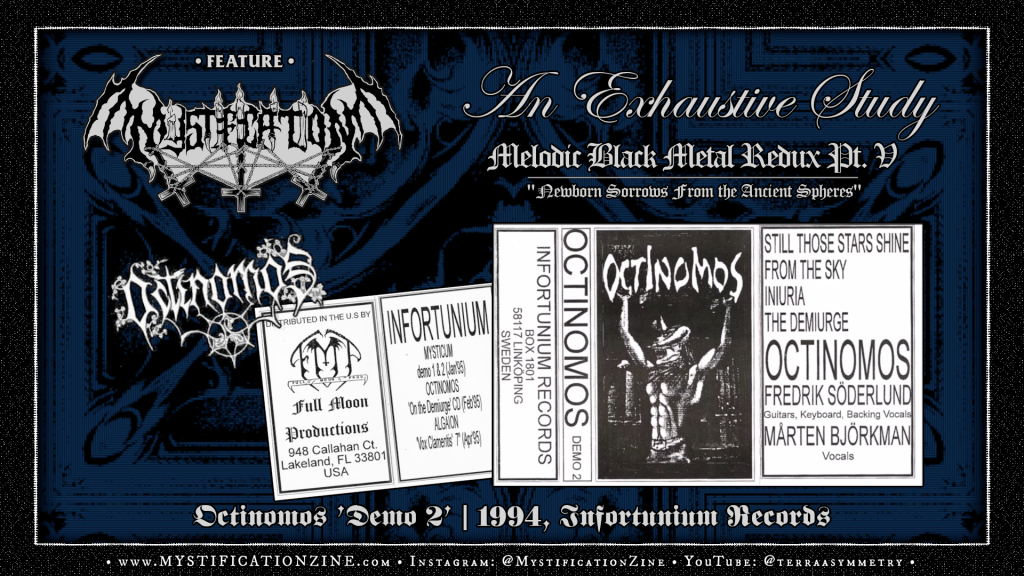
Linköping, Sweden-borne band Octinomos was originally a duo featuring the vision of guitarist/keyboardist and main composer Fredrik Söderlund (Puissance, Parnassus) and vocalist M. Björkman (Algaion, Arditi) both of whom had long-running martial industrial and/or neofolk projects running around the same time. We find the work here is severe, lightly symphonic in placement of its keyboards and presents austere melodies and frantic drum machine blasted work. Apparently two demos were recorded in 1994 but this was the only one they saw fit to release before M. Björkman left to focus on his two main projects. First and foremost Söderlund was a brilliantly innate guitarist for his time, feral in his approach yet sophisticated in meeting some of the standards presented by earlier black/death metal acts before 1994 and this stood out a bit more in hindsight. He’d clearly been intently aware of more than just the insular scenes nearby, even releasing a compilation of Mysticum‘s early demos in 1995 on his Infortunium Records imprint before he’d focus on his own projects. This tape gives us our first chance to mention early United States based black metal label Full Moon Productions which was founded in 1994 by Thorns of Petrified Zine who’d persisted well into the 2010’s with underground black metal releases/distro. I’m not sure how deep into the discography of this artist we’ll go but I wanted to include this demo and (eventually) their debut LP to help build some understanding of underground black metal voices in Sweden.
More Info:
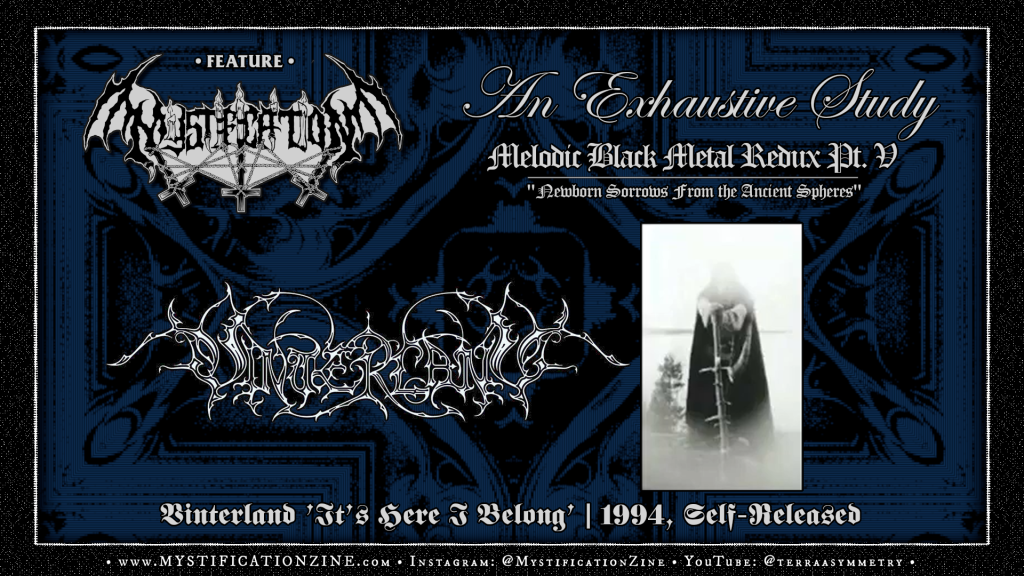
Central Sweden/southeast coast-based trio Vinterland formed circa 1992 (originally as Grimoires) and seemed to have a clear idea of what sort of romanticist, melancholic black metal they were working toward once their first two demo tapes arrived. Largely unfounded comparisons to Dissection and Sacramentum would come later on, though some of the guitar techniques on ‘It’s Here I Belong‘ certainly fit the No Fashion modus as they’d soon sign on for their debut LP circa 1996. Crystalline keyboards ring in the distance creating an almost tragedian atmosphere in a gothic (or, cinematic) metal sense as spoken word filters through the fairly sophisticated dual guitar interplay, clashing vocal performances and dramatic arcs already featured in their work. Though it will take some squinting of the ear to hear the nuances on this roughened tape this is one of the earlier melodic black metal bands, wherein I’d argue there was no pure death metal influence lingering in their work.
The title track to this tape would eventually be transformed into “Still The Night Is Awake” on their debut. Guitarist and co-vocalist Pehr Larsson would also play in death/thrash metal band Harmony who’d changed their name to Maze of Torment. You must check out their album ‘The Force‘ (1997) if you are a fan of his other work. Also, I believe he heads Alfahanne today, more of a black n’ roll/dark metal sort of group which often brings in guests from the old guard.
More Info:
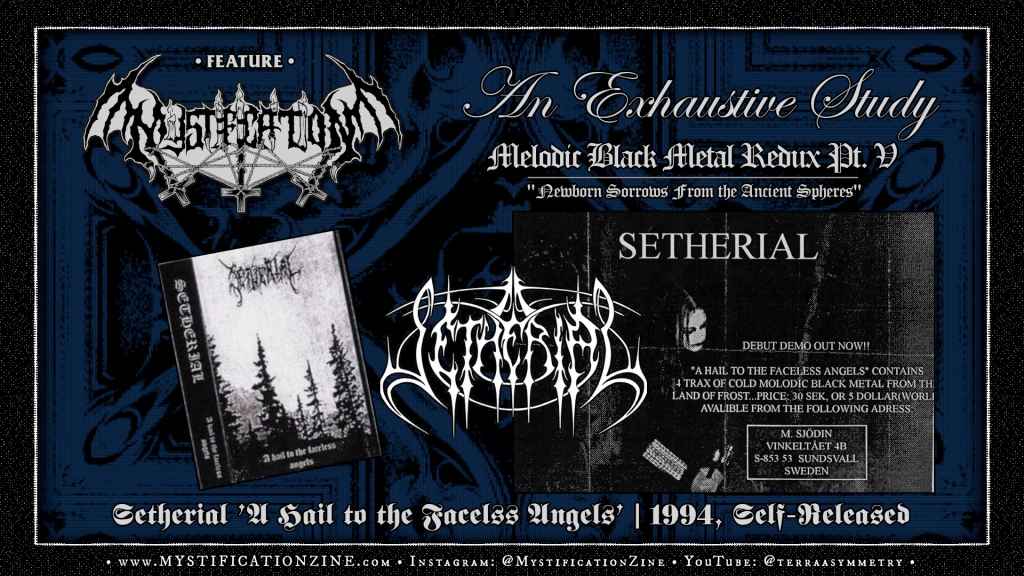
All hail Setherial circa 1994-1998 wherein Håkan Sjödin aka Mysteriis developed the band alongside In Battle (the self-titled record is all you need from them, in my opinion) but eventually chose to focus on this melodic black/death metal band. The Bathory-tinged dramatism of the title track is likely to win folks over quickly after the vocal effects in the intro piece might’ve lowered expectations. No doubt there are some fundamental lessons taken from the early days of Dissection here, at least I’d be surprised if not, but keep in mind the early line-up of this band basically featured key members of Blot Mine (later on) and Kheeroth vocalist of Midvinter‘s 1997 LP and owner of notable small label Near Dark Productions. This is one of my favorite tapes from this scene in the sense that it builds up the hype for the eventually reveal of ‘Nord…‘ in 1996, an album which I feel is rarely given credit for its aesthetic and compositional qualities.
‘A Hail to the Faceless Angels‘ initially acts as the missing link between the melodic black metal of the post-1995 crowd and the earlier death metal stuff, that is until “As a Shadow” reveals its heavy Deicide inspired death metal mosh grooves and the tape begins to take on a surreal quality otherwise, gaining momentum but losing atmosphere (a fair criticism of later work, too); The drummer on this tape Anders Löfgren aka Zathanel was a huge part of this scene having backed Sorhin, Midvinter, and Setherial as well as offshoot band Blot Mine and anyone who knows the high points of these bands understands what a vital part his work was for creating this distinct Swedish black metal sound. Napalm Records eventually released this demo tape along with some material from 1995 and 1998 as a compilation in 2003 on the walk up to and LP which also released that same year.
More Info:
YouTube: https://www.youtube.com/watch?v=tcGuFKdfCIY
Demo Compilation: https://www.youtube.com/watch?v=gNbtRo8g0mE

Oslo, Norway-borne black metal duo Isvind started as a trio of very young kids under the name Icewind circa 1992 but but 1993 one fellowe had left, leaving Arak Draconiiz and Goblin as the main longtime collaborators on the band. They’d released two demo tapes in 1994 and the only indication of which came first, as far as I can tell, is their feature order on compilations and the primitivity of ‘Nivelheimen‘ in comparison with ‘Herskerinnen‘. While we can hear the quite obvious inspiration taken from Darkthrone‘s third album at times much of this tape features the beginnings of their own melancholy-stricken, contemplative melodic style. I would label this as melodic black metal for its time and its scenery nearby, as these songs were remarkably driven by their guitar melodies which brought much more than savagery to their work. I’d found this tape brilliant in close study of the rhythms, rough as it is, but of course ’95-’97 were perhaps their best years.
More Info:
YouTube: https://www.youtube.com/watch?v=gQsVw7Jwer0
Nivelheimen demo: https://www.youtube.com/watch?v=1CLqpoIECpQ

Since I’d discovered black metal after many years listening intently to traditional death metal records and already had a taste for the traditions of thrash and such otherwise Dawn‘s debut full-length album ‘Nær sólen gar niþer for evogher‘ not only instantly appealed to me in my exploration but quickly became one of my all-time favorite extreme metal records, period. The escalation of the riffs, the intensity of the vocals, the scorching reverberation of the album as it reaches for its most intense peaks, and of course the still death metallic drumming of the record all creates a storm of mysterious and arcane Swedish black metal with its own distinct voice. Essential music.
Many things went into the realization of this record which make it such a standout, first of course is the bands ongoing relationship with Dan Swanö at Unisound Studio at the time since this both ensured their intent was understood but also that they would not sound like everyone else if they didn’t want to. Guitarist Fredrik Söderberg illuminated a fair amount about the album in a 2021 interview with No Clean Singing:
1.)They do not agree that the album was black/death metal but instead an amalgam of “heavy metal, thrash metal, death metal, alternative, and classical music/guitar.” Dawn created the album between 1992 and late 1993 (as evidenced by the transition within the demo era) while attempting to avoid the commercialization and commodification of death metal. 2.) Henke changed his vocals in admiration of the style found on debuts/demos from Eucharist and Sentenced (see why I’ve emphasized their releases so much in Parts III-IV?) You’ll find the time I spent addressing early melodic death metal will continue to pay off in understanding the language of melodic black metal for the rest of the 90’s.
I will say that you might have a different experience between the well-clarified and spacious remasters of the album and the original Necropolis Records release, I spent years listening to the original and that is where the haunting, cryptic nature of the release sticks with me though I think the remasters preserve Henke‘s vocals beautifully and let us hear the bass/keys a bit more. There are pros and cons to each version but I would suggest hearing all of them if you can manage it.
Trivia: The album released January 6th, 1994 via Paul Thind‘s Necropolis Records. Shamaatae of Arckanum wrote some the album’s lyrics in a dialect of ancient Swedish, in case you’ve had as much trouble as I have translating them. The title of the album means “When the sun goes down forever”.
More Info:
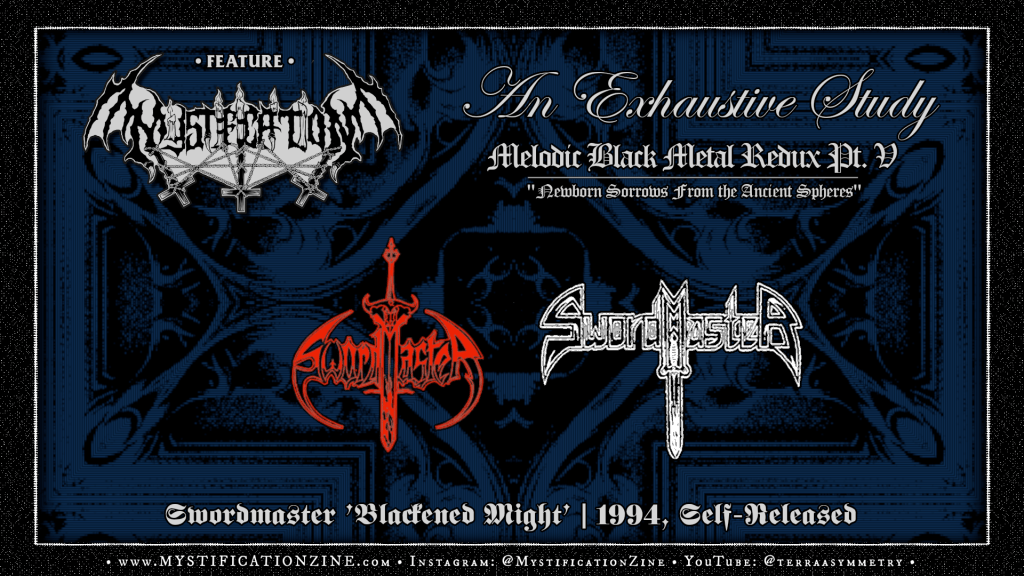
Gothenburg-borne band Swordmaster formed as a duo in the Summer of 1993 eventually pulling in Mattias Eliasson (Malicious Decay, Sarcastic) briefly before securing a line-up in 1995 and signing to the aforementioned Full Moon Productions. This tape was their most basic beginning as a trio wherein ‘Blackened Might‘ showcases the Dissection-esque side of guitarist/co-founder Emil Nödtveidt who would continue on with Opthalamia through the late 90’s but focus on this band ’til they’d become a melodic death/thrash band and then a popular gothic metal group (under the name Deathstars) by 2000. I don’t mean to tell the whole story here right off the bat but the notes are pretty basic here: Sombre but driven riffs, entirely instrumental demo tape, plenty of talent for complex rhythmic statement herein, and otherwise just a very basic introductory experience. We will talk about the band once more when ‘Wraths of Time‘ hits in 1995.
More Info:

Fredrikstad, Norway-borne quintet Carpathian Full Moon probably don’t belong on this list for the sake of ‘Serenades in Blood Minor‘ being basically a still-formative gothic metal album with influences taken from black metal and doom metal. Rasping vocals, gothic rock/darkwave influences abounding, harsh guitar distortion and some elements of nascent gothic metal fed into this short-lived quintet being considered melodic black metal. From my point of view this is what bands like Bethlehem and Katatonia had been defining (indirectly) as dark metal. You might also note that some of what Samael were doing around this time had been similarly troubled with confused rhythms, jutting between death metal shocks and alternative rock swings with stuttering semblance of black metal and its ‘symphonic’ tendencies. Chances are any release on Avantgarde Music around this time was at least somewhat related to gothic metal but I feel like this one has some charming weirdness to its dual guitar chaos, and maybe some of the leads will appeal to fans of something like ‘Triarchy of the Lost Lovers‘ even if the rhythms are kind of slow-rocking mush most of the time. While I had to resign to the fact that this record is not relevant to our search, it helps us to begin to resolutely distinguish actual melodic black metal from dark metal, gothic metal, and melodic/gothic doom metal.
More Info:

I won’t spend too much time on Algaion‘s second or (1.5th) demo ‘Heosphoros ho proi anatellon‘ since it includes two tracks we’ve already heard on their prior tape presented here with slightly more clarity and two new songs otherwise, I’d prefer to get right to the full-length from this point. Much like the first tape Matthias Kamijo is the guitarist, bassist and drum programmer but he’d began working with a different sense of pacing at this point, learning a bit more about drums and making something similarly styled in its melodic riffing but better mapped out. We can compare this bare-bones work with that of Octinomos at this point and see why they were kindred in some sense but, not directly. We attain a much more clear sense of the persistence of their rhythms and the development of each phrase herein, though the guitar style remains distinct it is not yet sophisticated to any satisfying degree as it relies on the early 90’s Greek black metal juddering rhythmic programming for propulsion. While this helps characterize this Luciferian band quickly they never quite took off to broader notice and perhaps because of associations with the darker themes of neofolk/martial industrial projects. The whole tape was recorded in a collective three days in early January 1994, no exacting release date.
More Info:
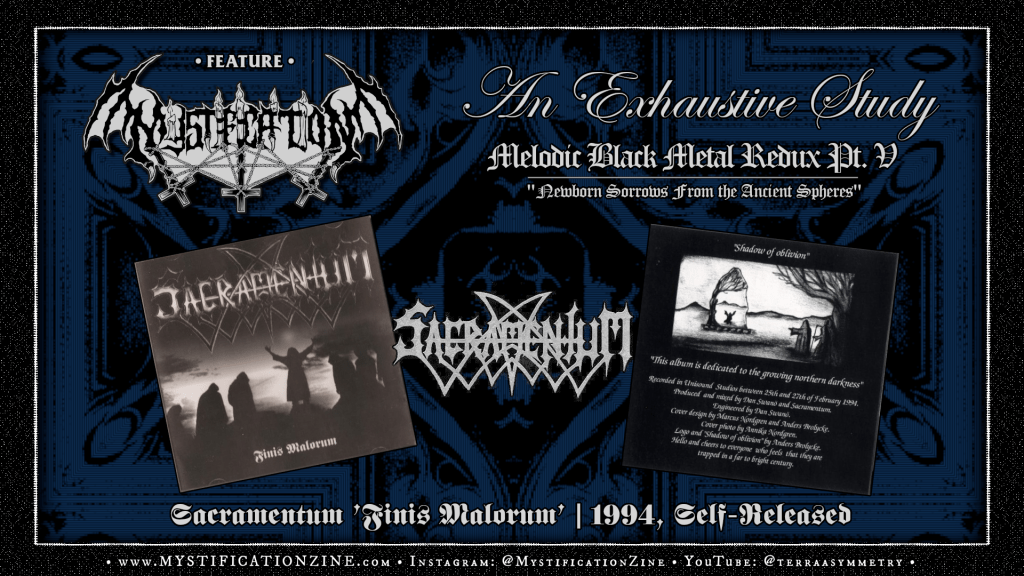
The thrill of finally arriving upon the shotgun blasted air that is Sacramentum‘s ‘Finis Malorum‘ is a deep breath of relief in a room without oxygen. Recorded in Unisound Studios in February 1994 no doubt maestro Swano did great things for the bands he’d worked with while giving these folks room to craft their own distinct self-produced sound. The original CD released around April as far as I know but can’t a hundred percent confirm. I consider this album an early masterpiece from a band who produced nothing but top-shelf melodic black/death metal. Note the increasingly sophisticated interwoven nature of the dual rhythm guitar arrangements, the intricacy of the leads in longform melodic phrase, the storming rush of the drums and how it overtakes the space with its atmospheric changes.
Some see this mLP as a precursor to greatness or a wobbly step towards mastery but from my point of view Sacramentum had arrived upon the crucial next step for Swedish melodic black/death metal sophistication here with this set of four songs. Of course you will notice the artificial drum sound and whatnot, this helps us point to an album like ‘A Velvet Creation‘ for reference, but it is of course the dual guitar work here which stuns us into the future with (much like Dawn) wherein influences coming from heavy metal, black metal, and classical music, even fitting in a Dissection-esque riff here and there on “Pagan Fire” where we hear the beautiful hum of the rhythm guitars in unison during certain verses. I suppose I will save some of my thoughts for when the everlasting ‘Far Away From the Sun‘ arrives a couple of years later but for now we have at least breached two of the best releases to come from Swedish melodic black metal relevancy in 1994. Though there will be more technical releases in this style to come I want to emphasize the melancholy they build within these staggered shapes, in this sense the early versions of some of these songs had very few peers at the time. At this point in our exploration I would suggest taking some time to let Sacramentum‘s work sink in, give it some time since we will have very, very few chances to experience this level of musical craft as we find many bands arriving upon similarly clever patternation throughout the late 90’s but none of the feeling, or, a less believable version.
More Info:
You’ll have noticed Swedish black metal almost completely overtook the first couple months of 1994 in terms of our relevant exploration, though we had some detours to Norway along the way. There will be several more releases to cover throughout our exploration of 1994 as we pick back up looking at March through June releases, likely covering about ~12 records, demos, a 7″ or two and such.



Help Support Grizzly Butts’ goals with a donation:
Please consider donating directly to site costs and project funding using PayPal.
$1.00
Make a one-time donation
Make a monthly donation
Make a yearly donation
Choose an amount
Or enter a custom amount
Your contribution is appreciated.
Your contribution is appreciated.
Your contribution is appreciated.
DonateDonate monthlyDonate yearly
